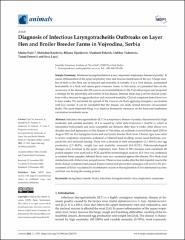Diagnosis of Infectious Laryngotracheitis Outbreaks on Layer Hen and Broiler Breeder Farms in Vojvodina, Serbia

View/
Date
2022Author
Pajić, Marko
Knežević, Slobodan
Đurđević, Biljana
Polaček, Vladimir
Todorović, Dalibor
Petrović, Tamaš
Lazić, Sava
Metadata
Show full item recordAbstract
Infectious laryngotracheitis (ILT) is a respiratory disease of poultry characterized by high
morbidity and variable mortality. ILT is caused by Gallid alpha herpesvirus-1 (GaHV-1), which is
transmitted horizontally and most susceptible are chickens older than 4 weeks. After almost two
decades since last appearance of this disease in Vojvodina, an outbreak occurred from April 2020 to
August 2021 on five laying hen farms and one broiler breeder flock farm. Clinical signs were mild
to severe respiratory symptoms, unilateral or bilateral head swelling, serous nasal discharge, conjunctivitis
and increased tearing. There was a decrease in feed consumption (2.1–40.0%) and egg
production (2.7–42.0%), weight loss and mortality increased (0.8–31.5%). Pathomorphological
changes were localized in the upper respiratory tract. Total of 200 carcasses were examined; 40
pooled samples were analyzed by PCR, and 40 by bacteriological analysis. ILT virus was confirmed
in tracheal tissue samples. Infected flocks were not vaccinated against this disease. Five flocks had
coinfection with Avibacterium paragallinarum. Three-to-four weeks after the first reported case in the
flock, clinical symptoms had ceased. Future control and prevention strategies will involve the procurement
of flocks vaccinated by recombinant vaccine or the registration of live attenuated vaccines
and their use during the rearing period.
